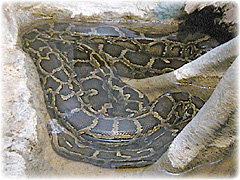Difference between revisions of "Burmese Python"
Jump to navigation
Jump to search
| Line 1: | Line 1: | ||
| − | {{ | + | {{OpenPagesTop}} |
[[Image:Burmese_python_240x180_border.jpg|250px|thumb|right|'''Burmese python''' (© RVC)]] | [[Image:Burmese_python_240x180_border.jpg|250px|thumb|right|'''Burmese python''' (© RVC)]] | ||
==Introduction== | ==Introduction== | ||
| Line 19: | Line 19: | ||
temperatures such as respiratory infections and necrotic stomatitis, anorexia and obesity. | temperatures such as respiratory infections and necrotic stomatitis, anorexia and obesity. | ||
| − | == | + | {{Learning |
| − | + | |literature search = [http://www.cabdirect.org/search.html?q=(od:(Burmese+Python)+OR+title:(Burmese+Python)+OR+ab:(Burmese+Python)+OR+od:(Python+molurus)+OR+title:(Python+molurus)+OR+ab:(Python+molurus))&fq=sc:%22ve%22 Burmese Python (''Python molurus'') publications] | |
| + | }} | ||
| − | + | {{review}} | |
| − | + | ||
| − | + | {{OpenPages}} | |
[[Category:Snake_Species]] | [[Category:Snake_Species]] | ||
[[Category:Lizard_and_Snake_Glossary]] | [[Category:Lizard_and_Snake_Glossary]] | ||
Revision as of 16:53, 18 August 2012
Introduction
The Burmese python (Python molurus) is a python (family Boidae). Their life span may be 10-15 years.
Morphology
Burmese pythons have an intricate pattern of markings of irregular brown blotches on a yellow background. The Burmese python is widely bred in captivity and comes in a number of mutant forms including albino. They can grow rapidly, attaining 2 metres in length in their first year and perhaps reaching 8 metres.
Free-Living
- Distribution – Burmese pythons are native to India, Ceylon and southeast Asia.
- Habitat – They are often found near water, and are both terrestrial and arboreal.
- Diet – Burmese pythons constrict mammals and birds.
Captivity
- Cage – Terrestrial and arboreal requirements are necessary and the size of cage should be related to the size of snake.
- Temperature - Optimum air temperature during the day is 29°C to 35°C (85°F to 95°F) and at night is 24°C to 27°C (75°F to 80°F). A temperature gradient should be provided so that the snake can move to slightly cooler or warmer temperatures.
- Humidity – A humidity of approximately 60% is preferred.
- Diet – A variety of prey can be fed and includes mice, rats, rabbits, chickens, and guinea pigs. Feed once to twice every 10 days.
- Reproduction – Burmese pythons are relatively easy to breed in captivity. They are oviparous and
usually lay between 30-50 eggs (up to 100 recorded). The female incubates the eggs by curling around them and "twitching" her muscles. The young are 45 to 60 cm at birth.
- Veterinary considerations - Common medical problems include diseases associated with low cage
temperatures such as respiratory infections and necrotic stomatitis, anorexia and obesity.
| Burmese Python Learning Resources | |
|---|---|
 Search for recent publications via CAB Abstract (CABI log in required) |
Burmese Python (Python molurus) publications |
| This article has been peer reviewed but is awaiting expert review. If you would like to help with this, please see more information about expert reviewing. |
Error in widget FBRecommend: unable to write file /var/www/wikivet.net/extensions/Widgets/compiled_templates/wrt663aaa005fe2b0_29549713 Error in widget google+: unable to write file /var/www/wikivet.net/extensions/Widgets/compiled_templates/wrt663aaa00635dd1_04665654 Error in widget TwitterTweet: unable to write file /var/www/wikivet.net/extensions/Widgets/compiled_templates/wrt663aaa00667db2_75746489
|
| WikiVet® Introduction - Help WikiVet - Report a Problem |
